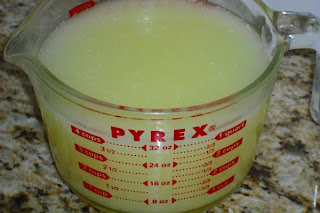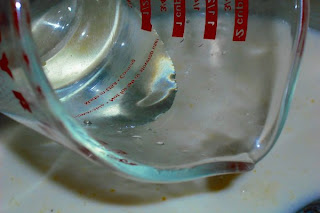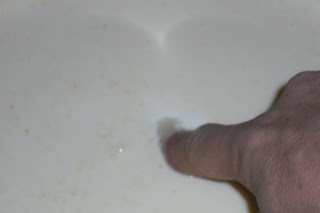Fresh Mozzarella Part 2
Before we begin you’re gonna need some equipment….
Place about 1 quart of water in each stock pot and heat them to a boil.

 Using the slotted spoon, scoop the curd into another stock pot filled with 2 quarts of cold distilled water.
Using the slotted spoon, scoop the curd into another stock pot filled with 2 quarts of cold distilled water.
 After they have cooled for about 15 minutes, pour the curds into a cheesecloth lined colander and let them drain.
After they have cooled for about 15 minutes, pour the curds into a cheesecloth lined colander and let them drain.
 Let them drain for about 10 minutes...
Let them drain for about 10 minutes...
 Pick the assembly up and place it in the smaller stock pot and place the lid on top of the colander and store the cheese at room temperature for the bacteria to grow and acidify the curds – about 8-10 hours (I let mine sit for 18)
Pick the assembly up and place it in the smaller stock pot and place the lid on top of the colander and store the cheese at room temperature for the bacteria to grow and acidify the curds – about 8-10 hours (I let mine sit for 18)
 Chill the reserved whey in the refrigerator (Although you can also leave this out overnight if you would like to acidify it as well)
Chill the reserved whey in the refrigerator (Although you can also leave this out overnight if you would like to acidify it as well)
Tune in tomorrow for the exciting conclusion -- I’m So Dizzy, My Cheese is Spinnin’
or check out to part 1 of the series-- Say Cheese!!!!
Before we begin you’re gonna need some equipment….
- 2 Stainless steel stock pots (4 quart and 6-8 quart)
- Colander
- A long knife
- Cheese cloth
- Temperature gage
- Slotted spoon
- Stainless steel measuring spoons
- Glass Measuring cups
Place about 1 quart of water in each stock pot and heat them to a boil.

Place measuring cups, spoons, knife blades and anything else that you will be using in the pots and cover with the lids… let steam for 5 minutes…. For the colander, a good steaming is in order, place the colander in the pot and place the lid on top of the colander to get it steamed well.
 You have got to be able to control the bacteria here. Wipe all counter surfaces and the sink with a mild bleach solution… Maybe I am a little paranoid, but the curd will be aging in this recipe, it’s not one of those, “add citric acid and use the microwave” types. So prepare your environment well to ensure the proper bacteria (the ones YOU are adding to the milk) are going to be the ones that grow and flourish.
You have got to be able to control the bacteria here. Wipe all counter surfaces and the sink with a mild bleach solution… Maybe I am a little paranoid, but the curd will be aging in this recipe, it’s not one of those, “add citric acid and use the microwave” types. So prepare your environment well to ensure the proper bacteria (the ones YOU are adding to the milk) are going to be the ones that grow and flourish.
If my mom was right, and cleanliness is next to Godliness, then making cheese is a religious experience. I cannot stress the cleanliness and sterilization enough… If you think it’s clean, go ahead and clean it again, better safe than sorry.
OK, now that I have succeeded in scaring everyone away from making cheese with my own “Pathogen Paranoia”.
Let’s begin… You will need the following ingredients…
1 gallon un-homogenized pasteurized milk (no Ultra-Pasteurization or Homogenization)
1/4 tsp Vegetable Rennet
3 TB Whole Milk Yogurt
3 TB Cultured Buttermilk
2 TB Crème Fraîche Salt
Lots of Distilled Water
Warm the milk to 90 degrees in your sterilized stainless steel pot over LOW heat, with the cover on. This must be done at very low heat to ensure it down not scorch, since the milk needs to remain covered and as sterile as possible before inoculation.
Meanwhile, in a small glass measuring cup, mix your vegetable rennet with 1/4 cup distilled water.
In another glass measuring cup, mix the Yogurt, Buttermilk, and if you are using it, the Crème Fraîche.
 When the milk hit’s 90 degrees, add the yogurt/buttermilk mixture and stir to disperse the culture throughout the milk.
When the milk hit’s 90 degrees, add the yogurt/buttermilk mixture and stir to disperse the culture throughout the milk.
 Wait approximately 15 minutes.
Wait approximately 15 minutes.
Then add the rennet mixture, stirring well with the slotted spoon to ensure it is mixed thoroughly.
 Cover the milk and let it sit for 45 minutes to 1 hour (Mine took 1 hour)
Cover the milk and let it sit for 45 minutes to 1 hour (Mine took 1 hour)
You will know the curd is ready when you get what is called a “clean break”, that is when you can stick your finger in and the curd splits without clinging to your finger like syrup.
 Using a long knife, cut the curds in a crisscross pattern, than at an angle to achieve a ¾ inch curd, or at least close to it.
Using a long knife, cut the curds in a crisscross pattern, than at an angle to achieve a ¾ inch curd, or at least close to it.
(I tried taking a picture, but everything was so 'white', that you could not see the lines where I had cut... Sorry)
Begin reheating the curds & whey to 90 degrees again, stirring gently and breaking up any larger curds into small pieces so they are as uniform as possible.

After re-warming and stirring, let the curd rest again for 15 minutes so proteins in the curds to “Squeeze” more whey out of themselves.
 Pour off some of the whey and save (you will need about 3 cups)
Pour off some of the whey and save (you will need about 3 cups)
 You have got to be able to control the bacteria here. Wipe all counter surfaces and the sink with a mild bleach solution… Maybe I am a little paranoid, but the curd will be aging in this recipe, it’s not one of those, “add citric acid and use the microwave” types. So prepare your environment well to ensure the proper bacteria (the ones YOU are adding to the milk) are going to be the ones that grow and flourish.
You have got to be able to control the bacteria here. Wipe all counter surfaces and the sink with a mild bleach solution… Maybe I am a little paranoid, but the curd will be aging in this recipe, it’s not one of those, “add citric acid and use the microwave” types. So prepare your environment well to ensure the proper bacteria (the ones YOU are adding to the milk) are going to be the ones that grow and flourish.If my mom was right, and cleanliness is next to Godliness, then making cheese is a religious experience. I cannot stress the cleanliness and sterilization enough… If you think it’s clean, go ahead and clean it again, better safe than sorry.
OK, now that I have succeeded in scaring everyone away from making cheese with my own “Pathogen Paranoia”.
Let’s begin… You will need the following ingredients…
1 gallon un-homogenized pasteurized milk (no Ultra-Pasteurization or Homogenization)
1/4 tsp Vegetable Rennet
3 TB Whole Milk Yogurt
3 TB Cultured Buttermilk
2 TB Crème Fraîche Salt
Lots of Distilled Water
Warm the milk to 90 degrees in your sterilized stainless steel pot over LOW heat, with the cover on. This must be done at very low heat to ensure it down not scorch, since the milk needs to remain covered and as sterile as possible before inoculation.
Meanwhile, in a small glass measuring cup, mix your vegetable rennet with 1/4 cup distilled water.
In another glass measuring cup, mix the Yogurt, Buttermilk, and if you are using it, the Crème Fraîche.
 When the milk hit’s 90 degrees, add the yogurt/buttermilk mixture and stir to disperse the culture throughout the milk.
When the milk hit’s 90 degrees, add the yogurt/buttermilk mixture and stir to disperse the culture throughout the milk. Wait approximately 15 minutes.
Wait approximately 15 minutes.Then add the rennet mixture, stirring well with the slotted spoon to ensure it is mixed thoroughly.
 Cover the milk and let it sit for 45 minutes to 1 hour (Mine took 1 hour)
Cover the milk and let it sit for 45 minutes to 1 hour (Mine took 1 hour)You will know the curd is ready when you get what is called a “clean break”, that is when you can stick your finger in and the curd splits without clinging to your finger like syrup.
 Using a long knife, cut the curds in a crisscross pattern, than at an angle to achieve a ¾ inch curd, or at least close to it.
Using a long knife, cut the curds in a crisscross pattern, than at an angle to achieve a ¾ inch curd, or at least close to it.(I tried taking a picture, but everything was so 'white', that you could not see the lines where I had cut... Sorry)
Begin reheating the curds & whey to 90 degrees again, stirring gently and breaking up any larger curds into small pieces so they are as uniform as possible.

After re-warming and stirring, let the curd rest again for 15 minutes so proteins in the curds to “Squeeze” more whey out of themselves.
 Pour off some of the whey and save (you will need about 3 cups)
Pour off some of the whey and save (you will need about 3 cups) Using the slotted spoon, scoop the curd into another stock pot filled with 2 quarts of cold distilled water.
Using the slotted spoon, scoop the curd into another stock pot filled with 2 quarts of cold distilled water. After they have cooled for about 15 minutes, pour the curds into a cheesecloth lined colander and let them drain.
After they have cooled for about 15 minutes, pour the curds into a cheesecloth lined colander and let them drain. Let them drain for about 10 minutes...
Let them drain for about 10 minutes... Pick the assembly up and place it in the smaller stock pot and place the lid on top of the colander and store the cheese at room temperature for the bacteria to grow and acidify the curds – about 8-10 hours (I let mine sit for 18)
Pick the assembly up and place it in the smaller stock pot and place the lid on top of the colander and store the cheese at room temperature for the bacteria to grow and acidify the curds – about 8-10 hours (I let mine sit for 18) Chill the reserved whey in the refrigerator (Although you can also leave this out overnight if you would like to acidify it as well)
Chill the reserved whey in the refrigerator (Although you can also leave this out overnight if you would like to acidify it as well)Tune in tomorrow for the exciting conclusion -- I’m So Dizzy, My Cheese is Spinnin’
or check out to part 1 of the series-- Say Cheese!!!!

5 comments:
Hey! Is that finger sterilized mister? LOL kidding aside, wow, I'm like totally facinated with this process. Can't wait 'til tomorrow ;)
You have much more patience (and better equipment) than I. I bet that cheese is mad good. Where did you get that diffuser? I could use one for when I make sauce.
Are you friends with little miss muffet? :P Seriously...that looks way awesome! screw the spider, he's wouldn't be scaring ME away from that!
DD - Yes, I washed my finger... but just my finger... LOL ;)
Bob - I picked it up from B B & B for some insanely cheap price like 5 bucks. I usually use it when I cook my 6 hour tomato sauce...
Danielle - HA HA, that just reminded me of Andrew 'Dice' Clay for some reason...
Shane , that is the most awesome thing I've ever seen . I've been to many fromagerie , but to know someone who does it at home in the traditional way is too damn cool . You are the man !
Post a Comment